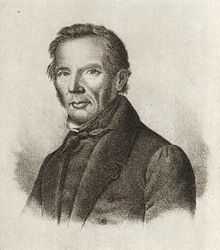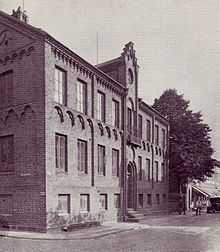Carl Georg Brunius


Carl Georg Brunius (Tanum 23 March 1793—Lund 12 November 1869[1]) was a classical scholar, art historian, archaeologist and architect working in the university town of Lund in southern Sweden.
Brunius was born on 23 March 1792 in Tanum parish (within the current Tanum Municipality), son of the vicar Gomer Brunius and his wife Mariana Rodhe. He studied at Lund University, where he became professor of Greek in 1824, served as rector in 1831 and 1841 and retired as professor emeritus in 1858.[2]
The focus in classical scholarship in the age in which Brunius worked was on the practical mastering of the languages, but beyond a few Latin poems, his contributions within his academic discipline were insignificant and had mostly ceased by the time he received his professorial chair.[3] Instead, he spent most of his life as a student of art, architecture and antiquities and as a working architect. With J. G. Liljegren, Brunius co-authored the first part of Nordiska fornlemningar ("Scandinavian antiquities"), published in 1819, and a work on petroglyphs. Brunius later produced the first systematic investigation of mediaeval art and architecture in current Sweden, writing substantial works on the history of art in Scania, on the island of Gotland and elsewhere.[4]
In his architectural work, Brunius wanted to revive the mediaeval styles, the Romanesque as well as the more fashionable Gothic, while he detested the more recent Baroque and Rococo styles. His career as an architect began with his work on Lund Cathedral in collaboration with the Stockholm architect Axel Nyström. The Cathedral had for some time been in severe need of restoration, and Nyström was given the job in 1832.[5]
Brunius had been a keen draughtsman already as a child and, when on one occasion he was threatened by his parents with being apprenticed to a mason rather than being allowed to continue in school, he had rather relished the thought.[6] He had been elected a member of the Lund Cathedral assembly (domkyrkoråd) in 1831 and was later elected chairman. As such, he was entrusted with the task of supervising the work on the Cathedral, which took more than 25 years to complete. On his own, Brunius designed or restored a number of other buildings in Lund, including the Bishop's House and a house for himself, as well as a large number of parish churches and other buildings in the surrounding province of Scania.[7]
Notes
References
- Rydbeck, Otto: "Brunius, Carl Georg", Svenskt biografiskt lexikon, 6 (1926), p. 506-514.